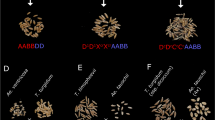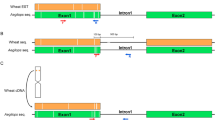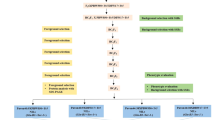Abstract
IT has been suggested1 that the most satisfactory way of transferring agriculturally advantageous characters to Triticum vulgare (2n = 42), bread wheat, from diploid species of related genera may be by the production of alien chromosome disomic additions or substitutions. During work concerned with the production of rye (Secale cereale) chromosome additions in T. vulgare, a 28-chromosome plant, which arose parthenogenetically in the progeny of the octoploid amphidiploid T. vulgare var. Holdfast × S. cereale var. King II, was crossed with the T. vulgare parent. A single F 1 plant was obtained, and this had 49 chromosomes which formed 21 bivalents and 7 univalents at meiosis, that is, it had the full T. vulgare complement plus the rye haploid complement of chromosomes. Our usual procedure is to make a further back-cross of such 49-chromosome plants to extract the 43-chromosome, monosomic addition, types which form the most frequent class in the aneuploid range obtained in this way. Afterwards, disomic addition types have been obtained in the progeny of selfed monosomic addition plants, and this work will be described elsewhere. However, this 49-chromosome F 1 plant was also allowed to self, and among the progeny obtained in this way was a plant with 44 chromosomes in which the two added rye chromosomes were identical. This may be recognized from the morphology of the chromosomes (Fig. 1), both of which had a sub-median centromere and a pronounced secondary constriction giving rise to a clear satellite. There is only one pair of chromosomes with this morphology in S. cereale (Fig. 2). The equivalence of the chromosomes is further proved by the occasional formation of 22 bivalents at meiosis. This plant had, therefore, the full complement of T. vulgare chromosomes plus a disomic rye chromosome.
This is a preview of subscription content, access via your institution
Access options
Subscribe to this journal
Receive 51 print issues and online access
$199.00 per year
only $3.90 per issue
Buy this article
- Purchase on Springer Link
- Instant access to full article PDF
Prices may be subject to local taxes which are calculated during checkout
Similar content being viewed by others
References
O'Mara, J. G., Genetics, 25, 401 (1940).
O'Mara, J. G., Cytologia, 16, 225 (1951).
Levan, A., Hereditas, 28, 177 (1942).
Taylor, J. W., J. Agric. Res., 48, 603 (1934).
Takagi, F., Cytologia, 6, 496 (1935).
Author information
Authors and Affiliations
Rights and permissions
About this article
Cite this article
CHAPMAN, V., RILEY, R. Disomic Addition of Rye Chromosome II to Wheat. Nature 175, 1091–1092 (1955). https://doi.org/10.1038/1751091a0
Issue Date:
DOI: https://doi.org/10.1038/1751091a0
This article is cited by
-
Generation and identification of a wheat–Agropyron cristatum (L.) Gaertn. 3P chromosome addition line and substitution line
Euphytica (2023)
-
Development and characterization of novel Triticum aestivum-Agropyron cristatum 6P Robertsonian translocation lines
Molecular Breeding (2021)
-
Detection of alien genetic introgressions in bread wheat using dot-blot genomic hybridisation
Molecular Breeding (2017)
-
The meiotic behaviour, fertility and stability of wheat-rye chromosome addition lines
Heredity (1960)
-
The production and phenotypes of wheat-rye chromosome addition lines
Heredity (1958)
Comments
By submitting a comment you agree to abide by our Terms and Community Guidelines. If you find something abusive or that does not comply with our terms or guidelines please flag it as inappropriate.



